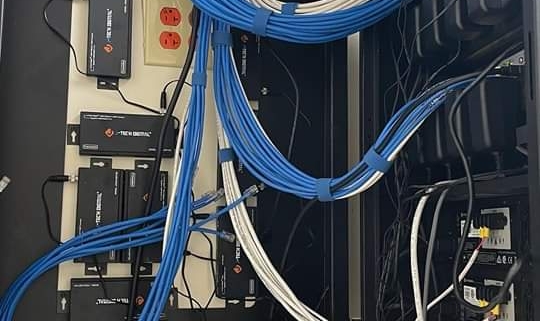Setting up a network can seem overwhelming, especially if you’re new to technology. Whether you’re installing a network at home or in a small office, understanding the basics can help ensure a smooth setup and efficient operation. This guide will walk you through the essential concepts of network installation, including equipment, planning, and best practices to get you started.
Understanding Network Basics
A network is a group of devices connected together so they can communicate and share resources. Networks can range from simple home setups to complex office systems. They usually include devices like computers, printers, routers, and switches.
Local Area Networks (LANs) connect devices within a small area, like a home or office, allowing them to share files, printers, and internet access. Wide Area Networks (WANs) cover a larger area and connect multiple LANs. The internet is the largest example of a WAN. Wireless networks use Wi-Fi to connect devices without the need for physical cables.
Essential Network Equipment
Router: The router is the main device in your network. It connects to your internet service provider (ISP) and manages data traffic between your network and the internet. Many modern routers also include built-in wireless access points for Wi-Fi connections.
Switch: Switches connect multiple wired devices within a network, allowing them to communicate efficiently. They are crucial for expanding network capabilities and improving performance.
Modem: The modem connects to your ISP and changes digital data from the internet into a format that your router and devices can understand. Often, a modem and router are combined into one device.
Access Point: An access point extends the range of your wireless network, allowing devices to connect from farther away. This is useful in large spaces where the main router’s signal might not reach every area.
Cabling: Network cables, like Ethernet cables, are used to connect devices to the router or switch. They are essential for wired connections, which are usually faster and more reliable than wireless ones.
Planning Your Network Installation
Assess Your Needs: Start by figuring out the size and scope of your network. Think about how many devices you need to connect, the types of activities (e.g., browsing, streaming, gaming), and the layout of your space.
Choose Your Equipment: Based on your needs, pick the right network equipment. For most home setups, a router with built-in Wi-Fi and a modem will be enough. For larger networks or office setups, you might need extra switches and access points.
Design the Layout: Plan where to place your router, switches, and access points. The router and access points should be placed in central locations to maximize their range and effectiveness.
Cable Management: Plan how to organize and manage your cables to avoid clutter and ensure an organized setup. Use cable organizers and keep cables away from high-traffic areas to prevent damage.
Installing the Network
Set Up the Modem and Router: Start by connecting the modem to your ISP’s connection point. Then connect the router to the modem using an Ethernet cable. Power on both devices and wait a few minutes for them to start up.
Configure the Router: To set up the router, access its settings using a computer or smartphone connected to the router. Open a web browser and enter the router’s IP address, which is usually something like 192.168.1.1. Log in using the default username and password found on the router or in the user manual.
Set Up Wireless Network: Configure your Wi-Fi settings, including the network name (SSID) and password. Choose a strong password to secure your network, and make sure your router’s firmware is updated for better performance and security.
Connect Devices: Connect your devices to the network by plugging Ethernet cables into the router or switch for wired devices, and searching for your network’s SSID on wireless devices. Enter the Wi-Fi password to connect.
Test Your Network: Once everything is connected, test your network to make sure internet access is working and that all devices can communicate with each other. Check that your Wi-Fi signal reaches all areas where you need it.
Securing Your Network
Change Default Credentials: Change the default username and password for your router’s admin settings to prevent unauthorized access.
Enable Encryption: Use WPA3 or WPA2 encryption for your Wi-Fi network to secure data transmitted over your wireless network.
Regular Firmware Updates: Keep your router’s firmware up to date to protect against security threats and improve performance.
Set Up a Guest Network: If you want to provide internet access to guests without giving them access to your main network, set up a separate guest network with its own password.
Monitor Network Activity: Use your router’s management interface to keep an eye on connected devices and network activity. Look out for any unfamiliar devices or unusual behavior.
Troubleshooting Common Issues
No Internet Connection: If you can’t access the internet, check the connections between your modem and router. Restart both devices and make sure all cables are securely plugged in. If the problem persists, contact your ISP.
Slow Speeds: If your network is slow, check for network congestion, outdated equipment, or interference. Ensure your router is centrally placed and away from electronic devices that might cause interference.
Wireless Coverage Issues: If you have weak Wi-Fi signals in certain areas, consider adding a wireless access point or range extender to improve coverage.
Device Connection Problems: If a device can’t connect to the network, check its Wi-Fi settings and ensure it’s within range of the router. Restart the device and try reconnecting.
Maintaining Your Network
Regular Updates: Regularly check for and install updates for your router’s firmware to keep it secure and performing well.
Clean Equipment: Dust and clean your network equipment periodically to prevent overheating and ensure it works properly.
Review Network Performance: Periodically review your network’s performance and adjust settings as needed to maintain optimal speed and reliability.
Backup Configurations: Keep a backup of your router’s settings in case you need to reset or replace the equipment.
Conclusion
Installing a network doesn’t have to be complicated. By understanding the basics, planning carefully, and following best practices, you can set up a reliable and efficient network for your home or office. Start with the right equipment, ensure proper placement and configuration, and take steps to secure and maintain your network. With these guidelines, you’ll be well on your way to a successful network installation.



Leave a Reply
Want to join the discussion?Feel free to contribute!